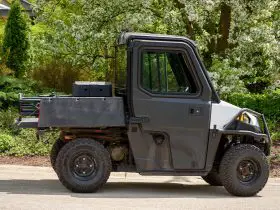Getting familiar with some of the important things in your UTV is the first thing to do. And, the list starts with knowing everything about the Polaris Ranger belt. UTV belts are an integral part when it comes to the performance of your side-by-side. Burnt and damaged belts cause various issues.
And, these might include a reduction in speed, jerkiness when taking off, and squeaking noises. In short, UTV belts are a necessary evil. Furthermore, replacing a worn belt is always better than replacing the whole transmission. But, when should a Polaris Ranger belt be replaced? Read on to find out more about it.
Table of Contents
How do you test a Polaris belt?
The right way to test the existing condition of a Polaris belt is to look out for the noises. Sometimes the belt will make mild noise that might occur at low speeds. However, the belt noises could be more and occur at a high-speed range.
To test the belt, use low gear at varying speeds and avoid high RPM. Also, avoid throttle for about 5 to 10 miles. If the vehicle doesn’t have low gear, try to avoid throttle for about 50 miles. Keep in mind that belts become hotter when you install them first and are sensitive to high loads. As such, they might break-in.
How do I know if my Polaris Ranger needs a new belt?
The best way to know when your Polaris Ranger will need a new belt is to consider your riding style and your temperament behind the wheel. Also, it will depend on other factors as well. And, one of them will be the budget. People who can spend more will swap drive belts before a long, tedious drive.
However, people who try hard to make money won’t follow this path. Hence, the precise answer to the question asked above is that there are no fixed criteria for that. You should change the belt whenever needed after conducting a thorough inspection.
Hence, look out for any signs of wear on the belt or keep a record of the miles you drove with the UTV. Besides, when you drive through snow, water, mud, etc., you need to check the belt more frequently.
It might surprise you but some drivers wait for their UTVs drive belts to blow up completely. Whereas, other riders tend to change the belt whenever they feel jerky while taking off, less power when engaging, and so on.
On the contrary, it is always good to check the condition of the drive belts after every tedious ride. And, you can do that with ease by using simple tools. As such, you can have a clear picture of the present condition of the belt by knowing the extent of the damages.
How long does a Ranger belt last?
According to the riders that drive conservatively, a single Ranger belt can last anywhere between 1500 and 2000 miles. Despite that, many riders tend to carry a spare belt and don’t mind replacing them in the field. Besides, some drivers prefer to change the drive belt after covering every 500 miles.
For these UTV enthusiasts, changing the belt after accomplishing the said distance is more like a law that they follow without fail. Also, they argue with other people that it is always better to buy a cheap belt compared to a new belt housing manifold and clutch cover if the belt chooses to burst.
What’s worse is that debris from the damaged belt can make the exit tubes clogged inside the clutch housing. Also, it can overheat the clutch or belt and cause a massive fire. There is no denying that being an off-road enthusiast, you may possess a certain amount of risk tolerance.
However, it is unwise to take calculated risks. Hence, replacing the worn-out belt with a new one prematurely helps you avoid greater damage that might occur.
How do you change it?
The best thing that you should do is change the Polaris Ranger drive belt in a garage. Also, make good use of cleaning solutions and the Polaris belt removal tool for this purpose. But if you can’t afford to buy the tool, there are other ways to change the Polaris Ranger belt efficiently.
One of the ways through which you can replace the belt without the belt removal tool is by using a screwdriver. So, stick the screwdriver into the slot and force push the clutch towards the motor. That way, the belt gets loose and generates enough slack for you to slide out.
After you remove the belt, all you have to do is reverse the steps that you did before. As such, you will put the new belt in the right place. So, replacing a new belt isn’t hard and it doesn’t take much time either.
How do you adjust it?
To make the new belt fit right, put the bike in neutral. Next, get the primary clutch into action. However, don’t go hard at it and turn it slowly. As a result, it will help the drive belt move toward the secondary clutch by sliding smoothly.
Besides, you can use a fender screw from the recommended tool kit and twist it into the sheave. Or else, you can use a pry bar to separate the clutch plates. Also, you can adjust the belt simply by putting the UTV in reverse and rolling the drive belt like you do with a bike chain.
Hence, with little strength and plenty of determination, anyone can change and adjust a Polaris Ranger drive belt the right way. However, with the right tools and tricks, changing the belt becomes more fun and the whole task completes in no time.
Are Polaris Rangers belt driven?
The most common type of transmission in a UTV is CVT or continuously variable transmission. It consists of a system that has a belt and a few pulleys. This design has been around for a very long time.
Most of the UTVs that come under the Polaris Ranger series come with a continuously variable transmission system. It means, most of them are belt driven and a few of them have shaft drive. The Polaris Ranger XP900 is a perfect example of it.
Related reading: What ATVs Are Belt Driven







